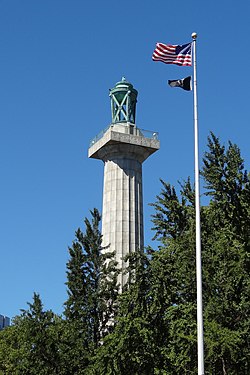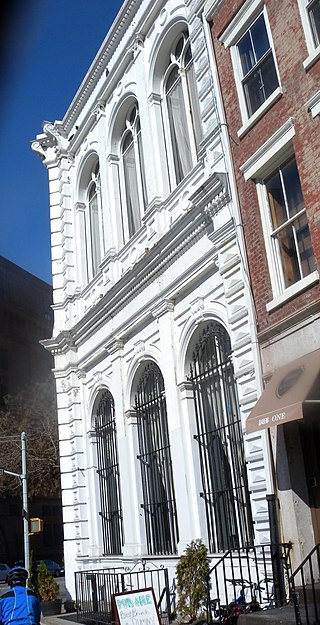
Fulton Ferry is a small area adjacent to Dumbo in the New York City borough of Brooklyn. The neighborhood is named for the Fulton Ferry, a prominent ferry line that crossed the East River between Manhattan and Brooklyn, and is also the name of the ferry slip on the Brooklyn side. The neighborhood is part of Brooklyn Community District 2.

This is intended to be a complete list of properties and districts listed on the National Register of Historic Places in Orleans County, New York. The locations of National Register properties and districts may be seen in a map by clicking on "Map of all coordinates". Two listings, the New York State Barge Canal and the Cobblestone Historic District, are further designated a National Historic Landmark.

This list is intended to be a complete compilation of properties and districts listed on the National Register of Historic Places in Rensselaer County, New York, United States. Seven of the properties are further designated National Historic Landmarks.

There are 75 properties listed on the National Register of Historic Places in Albany, New York, United States. Six are additionally designated as National Historic Landmarks (NHLs), the most of any city in the state after New York City. Another 14 are historic districts, for which 20 of the listings are also contributing properties. Two properties, both buildings, that had been listed in the past but have since been demolished have been delisted; one building that is also no longer extant remains listed.

Athens Lower Village Historic District is a national historic district located at Athens in Greene County, New York. The district contains 267 contributing buildings, including the Jan Van Loon House built in 1706. It includes residential, commercial, and ecclesiastical structures built primarily during the 19th century in a variety of popular architectural styles.

Coney Island Fire Station Pumping Station is a historic pumping station located in Brooklyn, New York, New York. It was built in 1938 in the Moderne style. It is a one-story, elliptical-shaped building faced in limestone. It sits on a granite base and has projecting porticos and metal doorways.

Rockwood Chocolate Factory Historic District is a historic industrial complex and national historic district in Fort Greene, Brooklyn, New York City. The complex consists of 16 contributing buildings built between 1891 and 1928 and owned by Rockwood & Company until it went out of business in 1957. The largest and oldest building dates to 1891 and is located at the corner of Washington and Park avenues. It is a five-story, Romanesque Revival style building. Much of the complex has been converted to loft apartments.

Boerum Hill Historic District is a national historic district in Boerum Hill, Brooklyn, New York City. It originally consisted of 238 contributing residential rowhouses and a few commercial buildings built between 1845 and 1890. Most are three bay, three story brick buildings with projecting stoops in a Greek Revival or Italianate style.

The Carroll Gardens Historic District is a small municipal and national historic district located in the Carroll Gardens neighborhood of Brooklyn, New York City. The national district consists of 134 contributing residential rowhouses built between the 1860s and 1880s. They are two- and three-story brownstone buildings in the neo-Grec and late Italianate styles located in a rectangle bounded by Carroll, President, Smith, and Hoyt Streets. They feature uniform setbacks, even cornice lines and stoop levels, and fenced front yards and landscaped gardens. These were the result of surveyor Richard Butt, who in 1846 planned gardens in front of the brownstone houses in the oldest section of the neighborhood. The homes are set farther back from the street than is common in Brooklyn, and the large gardens became an iconic depiction of the neighborhood. All the houses in the district, which is afforded a degree of privacy by the street pattern that discourages through traffic on Carroll and President Streets, were built between 1869 and 1884.
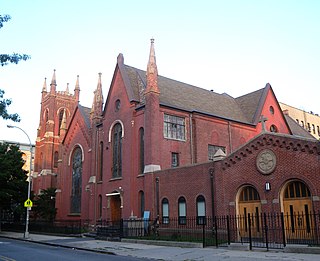
Clinton Hill Historic District is a national historic district in Clinton Hill, Brooklyn, in New York City. It consists of 1,063 largely residential contributing buildings built between the 1840s and 1930 in popular contemporary and revival styles. Buildings include freestanding mansions, row houses, and apartment buildings. The district includes the mansions of Clinton Avenue, built in the 1870s and 1880s. The most prominent of these are linked to Charles Pratt, who built a mansion for himself at 232 Clinton Avenue in 1874, the year his Charles Pratt & Company was acquired by Standard Oil, and one each as wedding presents for three of his four sons. These four mansions can be seen on Clinton Avenue between DeKalb and Willoughby. The rest of the historic district is noted for its prominent Italianate and Beaux-Arts rowhouses. The Clinton Hill South Historic District was listed in 1986.

Clinton Hill South Historic District is a national historic district in Clinton Hill, Brooklyn, in New York City. It consists of 246 largely residential contributing buildings built between the 1850s and 1922. It includes fine examples of Neo-Grec style row houses. Also in the district are a number of early 20th century apartment buildings in the Colonial Revival style.

Willoughby–Suydam Historic District is a national historic district in Brooklyn, New York, New York. It consists of 50 contributing residential buildings built between 1902 and 1904. They are three story brick tenements that have two apartments per floor. Some feature yellow and white terra cotta detailing.

Greenpoint Historic District is a national historic district in Greenpoint, Brooklyn, New York, New York. It consists of 363 contributing commercial and residential buildings built between 1850 and 1900. It includes both substantial and modest row houses and numerous walk-up apartment buildings, as well as a variety of commercial buildings including the former Eberhard Faber Pencil Factory, six churches, and two banks.

Senator Street Historic District is a national historic district in Bay Ridge, Brooklyn, New York, New York. It consists of 40 contributing residential buildings built between 1906 and 1912. They are all three story brownstone rowhouses in the Neo-Renaissance style. The houses feature high stoops and full sized subterranean basements.
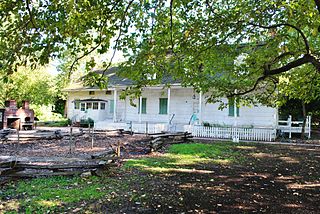
Lefferts Manor Historic District is a national historic district in Prospect Lefferts Gardens, Brooklyn, New York City. It consists of 667 contributing buildings and one contributing site, which were built between 1896 and 1935 on the subdivision established by James Lefferts in 1896. It consists entirely of single-family residential buildings, most of which are stone, brick, or brick and stone rowhouses. The district also includes a number of free-standing frame and masonry residences and garages.
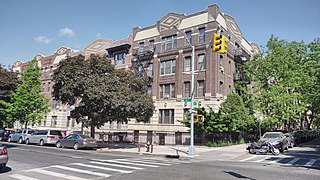
Park Slope Historic District is a national historic district in Park Slope, Brooklyn, New York, New York. It consists of 1,802 contributing buildings built between 1862 and about 1920. The 40-block district is almost exclusively residential and located adjacent to Prospect Park. It includes a variety of two and three story townhouses built in a variety of popular architectural styles of the late-19th and early 20th centuries. It was listed on the National Register of Historic Places in 1980.

Prospect Heights Historic District is a national historic district in Prospect Heights, Brooklyn, New York City. It consists of 305 contributing buildings built between 1865 and about 1900. The district is almost exclusively residential and includes a variety of single family rowhouses and multiple dwellings. They are in a variety of architectural styles popular in the late-19th century.
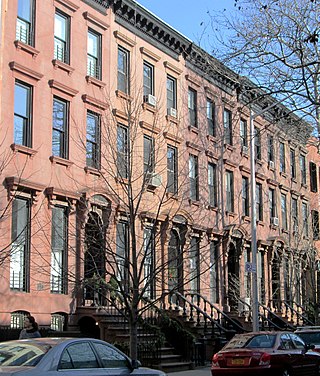
State Street Houses describes 23 Greek Revival and Italianate rowhouses built between 1847 and 1874 and located at 291-299 (odd) and 290-324 (even) State Street between Smith and Hoyt Streets in the Boerum Hill neighborhood of Brooklyn, New York City. The construction of the houses was part of the transformation of the formerly rural area into a fashionable new residential neighborhood.

Manhattan Avenue–West 120th–123rd Streets Historic District is a national historic district in the Harlem neighborhood of Manhattan in New York City. It consists of 113 contributing residential rowhouses built between 1886 and 1896. The buildings are three story brownstone and brick rowhouses over raised basements in the Queen Anne, Romanesque, and Neo-Grec styles.
This is a timeline and chronology of the history of Brooklyn, New York. Brooklyn is the most populous of New York City's boroughs, and was settled in 1646.
